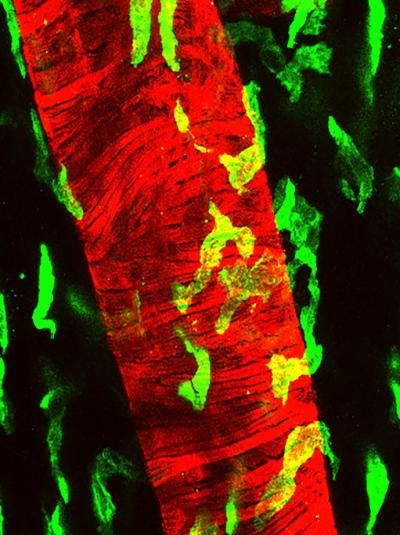Key to artery health lies in LYVE-1 macrophage

Macrophages coat the surface of blood vessel to maintain their structure and function. Green: macrophage; Red: blood vessel. Credit: Dr. Veronique Angeli
A team of researchers at NUS Medicine, led by Associate Professor Veronique Angeli, has identified a population of cells called macrophages that coat the outer walls of healthy arteries and express a protein called LYVE-1.
The researchers found that when these cells were absent, arteries accumulate collagen and lose their elasticity, becoming stiff and inflexible.
These findings suggested that the macrophages protect our arteries from becoming stiff, a concept that the team proceeded to prove.
They showed that the macrophages interact with another type of cell residing in the artery called smooth muscle cells, which produce collagen. The interaction between the two types of cell reduces the production of collagen by the smooth muscle cells.
Associate Professor Angeli and team showed that the LYVE-1 protein on the macrophages is actually responsible for this protective effect.
LYVE-1 binds to a molecule called hyaluronan expressed at the surface of smooth muscle cells and this interaction is required for the degradation of collagen by an enzyme called matrix metalloproteinase 9 (MMP-9).
The work has clinical implications for both aging and cardiovascular diseases because arterial stiffness is associated with aging and precedes cardiovascular diseases such as atherosclerosis and aneurysm.
This knowledge should help in the development of new treatments or the improvement of existing treatments for arterial diseases.
Media Contact
More Information:
http://dx.doi.org/10.1016/j.immuni.2018.06.008All latest news from the category: Health and Medicine
This subject area encompasses research and studies in the field of human medicine.
Among the wide-ranging list of topics covered here are anesthesiology, anatomy, surgery, human genetics, hygiene and environmental medicine, internal medicine, neurology, pharmacology, physiology, urology and dental medicine.
Newest articles

A universal framework for spatial biology
SpatialData is a freely accessible tool to unify and integrate data from different omics technologies accounting for spatial information, which can provide holistic insights into health and disease. Biological processes…

How complex biological processes arise
A $20 million grant from the U.S. National Science Foundation (NSF) will support the establishment and operation of the National Synthesis Center for Emergence in the Molecular and Cellular Sciences (NCEMS) at…

Airborne single-photon lidar system achieves high-resolution 3D imaging
Compact, low-power system opens doors for photon-efficient drone and satellite-based environmental monitoring and mapping. Researchers have developed a compact and lightweight single-photon airborne lidar system that can acquire high-resolution 3D…





















